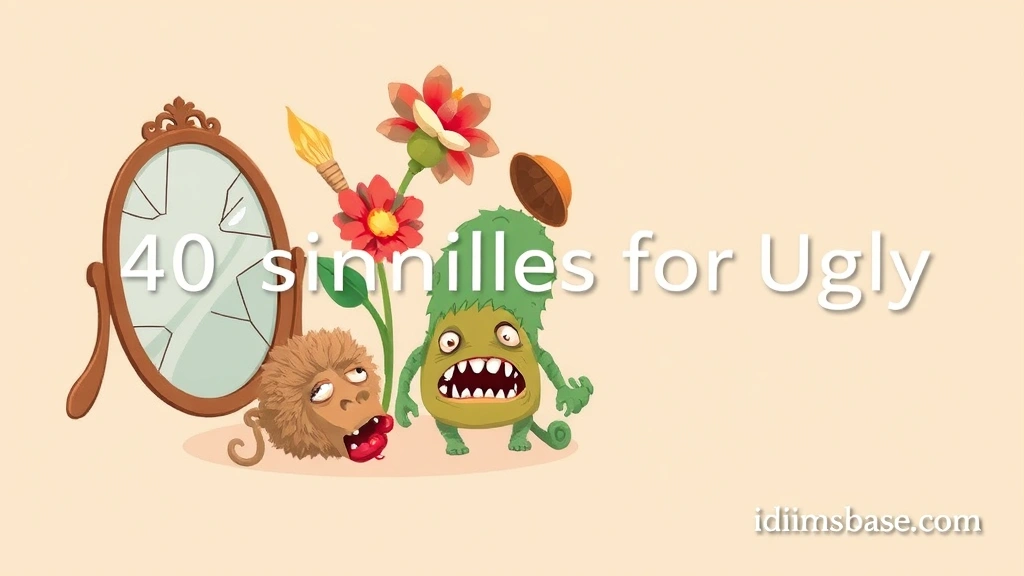Have you ever found yourself searching for just the right words to describe something… well, less than beautiful? Perhaps you’ve seen a truly disastrous outfit, a particularly unappealing dish, or even a piece of art that left you scratching your head. Sometimes, "ugly" just doesn't cut it. We need something more vivid, more descriptive, something that truly captures the essence of its unsightliness.
That's where similes come in! Similes are like little magic wands for your words, allowing you to compare one thing to another using "like" or "as." They paint a picture, add humor, and make your descriptions unforgettable. And when it comes to describing something as "ugly," oh, the possibilities are endless!
Join us on a fun journey as we explore 40 creative and sometimes hilarious similes for ugly. Get ready to expand your vocabulary and maybe even chuckle a bit.
The Art of Describing "Ugly"
Before we dive into our list, let's chat about why similes are so powerful. They don't just tell you something is ugly; they show you how it's ugly. Is it ugly like a squashed bug? Or ugly like a bad dream? Each simile carries its own unique flavor and implication.
Using similes also adds a touch of creativity and flair to your writing and conversations. It shows you're not just settling for the obvious word. You're thinking outside the box, and that's always impressive!
Why We Need More Than Just "Ugly"
"Ugly" is a pretty blunt instrument, isn't it? It's a general term that doesn't really convey the type of unattractiveness. Is it visually jarring? Is it decaying? Is it just plain unpleasant to look at? Similes help us get specific.
Imagine trying to describe a truly awful painting. Saying "it's ugly" doesn't tell your friend much. But saying "it's ugly as a mud fence" gives them a much clearer, albeit humorous, image.
40 Similes for Ugly
Ready to get descriptive? Here are 40 fantastic similes to help you describe something as "ugly" in a myriad of memorable ways. Some are classic, some are quirky, and all are designed to spark your imagination!
- Ugly as sin: A classic, implying something is morally or aesthetically repulsive.
- Ugly as a mud fence: Suggests something is crudely built and unappealing.
- Ugly as a warthog: A direct comparison to an animal not typically known for its beauty.
- Ugly as a toad: Similar to a warthog, referencing an amphibian often perceived as unattractive.
- Ugly as a scarecrow: Implies a disheveled, perhaps frightening, appearance.
- Ugly as a discarded rag doll: Suggests something worn out, shapeless, and unloved.
- Ugly as a festering wound: A vivid, somewhat gruesome comparison implying extreme unpleasantness.
- Ugly as a crumpled paper bag: Describes something shapeless, unappealing, and without form.
- Ugly as a broken doll: Evokes a sense of disrepair and sadness.
- Ugly as a smashed pumpkin: Suggests something ruined, messy, and past its prime.
- Ugly as a rotten apple: Implies decay, spoilage, and an unpleasant inner quality.
- Ugly as a poorly patched quilt: Describes something haphazardly put together and visually jarring.
- Ugly as a poorly drawn caricature: Suggests an exaggerated, unflattering, and distorted appearance.
- Ugly as a back alley dumpster: Conveys a sense of filth, neglect, and general unpleasantness.
- Ugly as a burnt toast: Implies something overdone, ruined, and unappetizing.
- Ugly as a bad dream: Suggests something disturbing, nightmarish, and unpleasant to even think about.
- Ugly as a poorly designed website: A modern comparison for something visually chaotic and difficult to navigate.
- Ugly as mismatched socks: Implies a lack of harmony and an unkempt appearance.
- Ugly as a discarded chewing gum: Suggests something sticky, shapeless, and something you wouldn't want to touch.
- Ugly as a rusty nail: Implies something old, neglected, and potentially harmful.
- Ugly as a flat tire: Describes something deflated, useless, and in need of repair.
- Ugly as a neglected garden: Suggests something overgrown, wild, and past its beauty.
- Ugly as a poorly constructed building: Implies a lack of care, poor craftsmanship, and an unstable appearance.
- Ugly as a broken mirror: Suggests fragmentation, distortion, and bad luck.
- Ugly as a withered flower: Implies something that has lost its vibrancy and is decaying.
- Ugly as a deflated balloon: Describes something that has lost its shape and joy.
- Ugly as a pile of dirty laundry: Conveys a sense of messiness, neglect, and unpleasantness.
- Ugly as a squashed bug: A visceral comparison for something truly repulsive.
- Ugly as a mangled piece of metal: Implies severe damage and distortion.
- Ugly as a broken record: Suggests something repetitive and irritating, visually or otherwise.
- Ugly as a lopsided cake: Implies poor symmetry and a failed attempt at something beautiful.
- Ugly as a crooked smile: Suggests an unsettling or unnatural expression.
- Ugly as a badly knitted sweater: Describes something ill-fitting, lumpy, and unappealing.
- Ugly as a decaying tooth: A somewhat gross comparison for something visibly unpleasant and unhealthy.
- Ugly as a poorly rehearsed play: Implies a lack of polish and an overall unappealing performance.
- Ugly as a forgotten toy: Suggests something discarded, dusty, and unloved.
- Ugly as a mismatched puzzle piece: Implies something that doesn't fit, creating visual disharmony.
- Ugly as a scrawled note: Describes something messy, illegible, and lacking care.
- Ugly as a cracked pavement: Implies neglect, disrepair, and a rough surface.
- Ugly as a half-eaten sandwich left out: Conveys something unappetizing, stale, and unpleasant.
How to Use These Similes Effectively
Now that you have a treasure trove of similes, how do you use them like a pro? It's all about context and impact!

Choosing the Right Simile
Think about the specific type of "ugly" you're trying to convey.
- For something structurally unappealing: "Ugly as a mud fence" or "ugly as a poorly constructed building."
- For something messy or neglected: "Ugly as a pile of dirty laundry" or "ugly as a discarded rag doll."
- For something truly repulsive: "Ugly as a festering wound" or "ugly as a squashed bug."
- For something disappointing or ruined: "Ugly as a burnt toast" or "ugly as a smashed pumpkin."
The more precise your simile, the more vivid your description will be!
Adding Humor or Emphasis
Many of these similes have a touch of humor, especially when used in casual conversation. Saying "That outfit is ugly as a back alley dumpster!" is far more entertaining than just "That outfit is ugly."
You can also use them for emphasis. "The situation was ugly as sin" truly communicates the severity of a bad situation.

Practice Makes Perfect!
Try incorporating a few of these into your daily conversations or writing. You'll be surprised how quickly you start to naturally use more descriptive language.
FAQs: All Your Questions About Similes for "Ugly" Answered!
Have more questions about using similes, especially for something less-than-beautiful? We've got you covered!
Q1: What is a simile, and how is it different from a metaphor?
A simile is a figure of speech that directly compares two different things using the words "like" or "as." For example, "The car was as fast as a cheetah."
A metaphor, on the other hand, directly states that one thing is another, without using "like" or "as." For example, "The car was a cheetah on the highway." Metaphors create a stronger, more direct identification, while similes draw a comparison.

Q2: Why use a simile instead of just saying "ugly"?
Using a simile adds depth, imagery, and often humor to your description. "Ugly" is a general term, but a simile, like "ugly as a mud fence," paints a specific, vivid picture in the reader's or listener's mind. It makes your language more engaging and memorable. It also allows you to convey the type or quality of unattractiveness.
Q3: Can similes for "ugly" be offensive?
This is a great question! While many similes are used playfully or to describe inanimate objects, some can be offensive if used to describe people, especially based on their appearance. For example, comparing a person's looks to something inherently negative can be hurtful. It's crucial to be mindful of your audience and the context. When in doubt, stick to describing objects or situations rather than individuals. Always aim for respect and kindness in your language.
Q4: Are there positive similes for "ugly"?
Not directly, as "ugly" by definition means unpleasant to look at. However, you can use similes to describe something that starts ugly but becomes beautiful, or something that is "ugly" in a charming or endearing way. For instance, "The old house was ugly as a forgotten toy, but it had a charm like a well-worn book." Here, the second simile adds a positive spin to something initially described as ugly. The "ugly duckling" story is a classic example of this transformation.
Q5: How do I come up with my own similes?
It's fun to create your own similes! Here's a simple process:
- Identify the quality: What specific aspect of "ugly" are you trying to describe? Is it messy? Distorted? Decaying?
- Brainstorm unrelated things: Think of objects, animals, or situations that share that specific quality, even if they're completely different from what you're describing. For example, if you want to describe something messy, think of a pigsty, a tangled ball of yarn, or a child's toy room after playtime.
- Connect them with "like" or "as": "The room was as messy as a pigsty."
- Refine: Does it sound good? Is it clear? Does it evoke the right image?
Practice this, and you'll become a simile-generating machine!
Q6: Can similes be used in formal writing?
Yes, but with caution! In creative writing (novels, poetry, short stories), similes are highly valued for their descriptive power. In more formal or academic writing, they can be used sparingly to clarify a complex idea or make a point more memorable, but they should always enhance clarity and professionalism, not distract from it. Avoid overly casual or humorous similes in very formal contexts.
Key Takeaways
We've covered a lot of ground today, haven't we? Here are the main points to remember about describing "ugly" with flair:
- "Ugly" isn't enough: The word "ugly" is too general. Similes allow you to paint a specific and vivid picture of what you mean.
- Similes add imagery: By comparing something ugly to another thing using "like" or "as," you create a strong visual in the reader's mind.
- They can add humor and emphasis: Many similes for "ugly" have a playful or exaggerated quality that makes your language more engaging.
- Context is key: Always consider your audience and the situation when choosing a simile, especially to avoid causing offense.
- Practice makes perfect: The more you experiment with similes, the more natural and effective your descriptive language will become.
So, the next time you encounter something that's less than lovely, don't just say "it's ugly." Reach into your newfound vocabulary and pull out a simile that truly captures its unique brand of unloveliness! You'll be amazed at how much more colorful and engaging your descriptions become. Which of these similes is your favorite? Do you have any unique ones we missed? Share your thoughts in the comments below! We'd love to hear from you!






